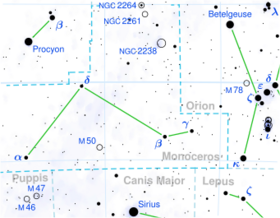Astronomy:19 Monocerotis
| Observation data Equinox J2000.0]] (ICRS) | |
|---|---|
| Constellation | Monoceros |
| Right ascension | 07h 02m 54.77667s[1] |
| Declination | −04° 14′ 21.2377″[1] |
| Apparent magnitude (V) | 5.00[2] |
| Characteristics | |
| Spectral type | B2Vn(e)[3]or B1V[4] |
| U−B color index | −0.93[2] |
| B−V color index | −0.20[2] |
| Variable type | β Cep[5] |
| Astrometry | |
| Radial velocity (Rv) | +24.80[6] km/s |
| Proper motion (μ) | RA: −5.05[1] mas/yr Dec.: +2.24[1] mas/yr |
| Parallax (π) | 2.68 ± 0.22[1] mas |
| Distance | 1,220 ± 100 ly (370 ± 30 pc) |
| Absolute magnitude (MV) | −2.85[7] |
| Details | |
| Mass | 12.3[8] M☉ |
| Radius | 9±3[9] R☉ |
| Luminosity | 4,817[7] L☉ |
| Surface gravity (log g) | 3.662[10] cgs |
| Temperature | 25,400[11] K |
| Rotational velocity (v sin i) | 274±3[9] km/s |
| Other designations | |
| Database references | |
| SIMBAD | data |
19 Monocerotis is a single,[12] variable star[5] in the equatorial constellation of Monoceros, located approximately 1,220 light years away from the Sun based on parallax.[1] It has the variable star designation V637 Monocerotis, while 19 Monocerotis is the Flamsteed designation. This object is visible to the naked eye as a faint, blue-white hued star with a baseline apparent visual magnitude of 5.00.[2] It is receding from the Earth with a heliocentric radial velocity of +25 km/s.[6]
This massive, B-type main-sequence star has a stellar classification of B1 V.[4] It is a Beta Cephei variable, ranging from 5.01 to 4.96 magnitude with a period of 0.19 days.[5] Closer examination shows there are three frequencies present, consisting of 5.22994, 0.17017, and 4.88956 cycles per day.[9] At one point it was thought to be a marginal Be star, but this was not confirmed.[9] The star is spinning rapidly with a projected rotational velocity of 274 km/s.[9] It has 12.3[8] times the mass of the Sun and is radiating 4,817[7] times the Sun's luminosity from its photosphere at an effective temperature of 25,400 K.[11]
References
- ↑ 1.0 1.1 1.2 1.3 1.4 1.5 Van Leeuwen, F. (2007). "Validation of the new Hipparcos reduction". Astronomy and Astrophysics 474 (2): 653–664. doi:10.1051/0004-6361:20078357. Bibcode: 2007A&A...474..653V. Vizier catalog entry
- ↑ 2.0 2.1 2.2 2.3 Ducati, J. R. (2002). "VizieR Online Data Catalog: Catalogue of Stellar Photometry in Johnson's 11-color system". CDS/ADC Collection of Electronic Catalogues 2237. Bibcode: 2002yCat.2237....0D.
- ↑ 3.0 3.1 "19 Mon". SIMBAD. Centre de données astronomiques de Strasbourg. http://simbad.u-strasbg.fr/simbad/sim-basic?Ident=19+Mon.
- ↑ 4.0 4.1 Hoffleit, D.; Warren, W. H. (1995). "VizieR Online Data Catalog: Bright Star Catalogue, 5th Revised Ed. (Hoffleit+, 1991)". VizieR On-line Data Catalog: V/50. Originally Published in: 1964BS....C......0H 5050. Bibcode: 1995yCat.5050....0H.
- ↑ 5.0 5.1 5.2 Samus, N. N. et al. (2009). "VizieR Online Data Catalog: General Catalogue of Variable Stars (Samus+ 2007-2013)". VizieR On-line Data Catalog: B/GCVS. Originally Published in: 2009yCat....102025S 1. Bibcode: 2009yCat....102025S.
- ↑ 6.0 6.1 Wilson, R. E. (1953). "General Catalogue of Stellar Radial Velocities". Carnegie Institute Washington D.C. Publication (Carnegie Institution of Washington). ISBN 9780598216885. Bibcode: 1953GCRV..C......0W.
- ↑ 7.0 7.1 7.2 Anderson, E.; Francis, Ch. (2012). "XHIP: An extended hipparcos compilation". Astronomy Letters 38 (5): 331. doi:10.1134/S1063773712050015. Bibcode: 2012AstL...38..331A. Vizier catalog entry
- ↑ 8.0 8.1 Tetzlaff, N.; Neuhäuser, R.; Hohle, M. M. (2011). "A catalogue of young runaway Hipparcos stars within 3 kpc from the Sun". Monthly Notices of the Royal Astronomical Society 410 (1): 190–200. doi:10.1111/j.1365-2966.2010.17434.x. Bibcode: 2011MNRAS.410..190T. Vizier catalog entry
- ↑ 9.0 9.1 9.2 9.3 9.4 Balona, L. A. et al. (July 2002). "Short-period line profile and light variations in the Beta Cephei star 19 Monocerotis". Monthly Notices of the Royal Astronomical Society 333 (4): 952–960. doi:10.1046/j.1365-8711.2002.05487.x. Bibcode: 2002MNRAS.333..952B. http://doc.rero.ch/record/297096/files/333-4-952.pdf.
- ↑ Soubiran, Caroline; Le Campion, Jean-François; Brouillet, Nathalie; Chemin, Laurent (2016). "The PASTEL catalogue: 2016 version". Astronomy & Astrophysics 591: A118. doi:10.1051/0004-6361/201628497. Bibcode: 2016A&A...591A.118S.
- ↑ 11.0 11.1 Hohle, M.M.; Neuhäuser, R.; Schutz, B.F. (2010). "Masses and luminosities of O- and B-type stars and red supergiants". Astronomische Nachrichten 331 (4): 349. doi:10.1002/asna.200911355. Bibcode: 2010AN....331..349H. Vizier catalog entry
- ↑ Eggleton, P. P.; Tokovinin, A. A. (September 2008). "A catalogue of multiplicity among bright stellar systems". Monthly Notices of the Royal Astronomical Society 389 (2): 869–879. doi:10.1111/j.1365-2966.2008.13596.x. Bibcode: 2008MNRAS.389..869E.
- ↑ "MAST: Barbara A. Mikulski Archive for Space Telescopes". Space Telescope Science Institute. https://mast.stsci.edu/portal/Mashup/Clients/Mast/Portal.html.
 |



